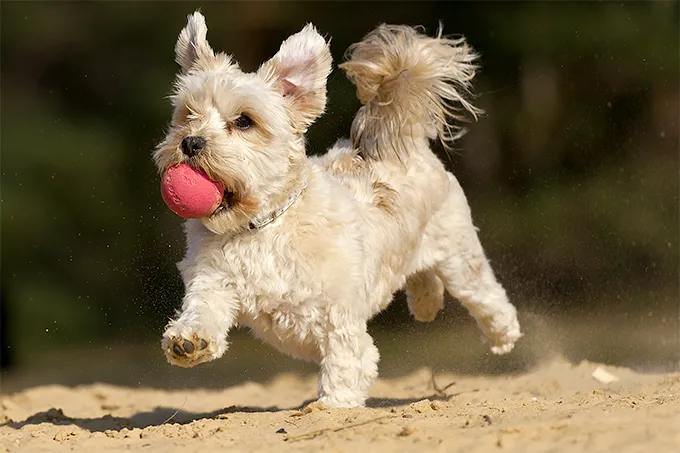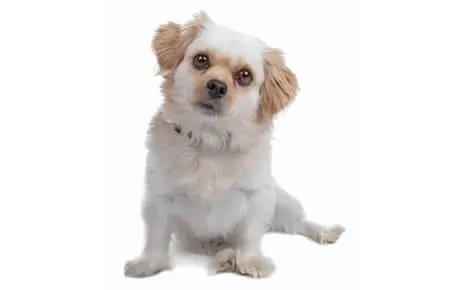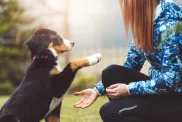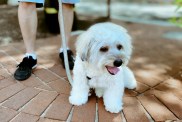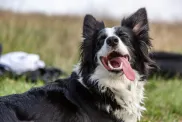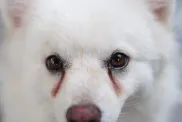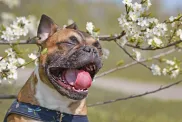The Maltese Shih Tzu, also known as the Mal-Shi, Malti zu, and the Malt-Tzu, is a hybrid or mixed dog breed — a cross between the Maltese and Shih Tzu breeds. Created with the same goal as Doodles — to be a small, allergy-friendly companion who doesn’t shed much — this hybrid is a sweet lapdog who likes to play with the kids.
Despite their unfortunate status as a designer breed, you may find these dogs in the care of shelters and rescue groups. Remember to adopt! Don’t shop if you want to bring a dog home.
One of the few “designer dogs” not originating with a Poodle, and therefore not one of the ubiquitous “Poo” or “Doodle” hybrids, this adaptable mix makes for an adorable, sweet little pooch with a long name. They can live in apartments or large homes, and even novice pet parents will also find these pups to be highly trainable and eager to please. If you’re looking for a tiny, low maintenance cuddle buddy for the whole family, then this may be the perfect dog breed mix for you!
See below for complete list of hybrid dog breed traits and facts about Maltese Shih Tzus!
Maltese Shih Tzu Hybrid Dog Breed Pictures
Adaptability
-
Adapts Well To Apartment Living
Looking for the best dog for your apartment? Contrary to popular belief, the suitability of dogs who adapt well to apartment living goes beyond its size. Apartment dwellers have a myriad of dog breeds to choose from as potential companions, with various factors to consider. Some large breeds can adapt well to apartment living and have lower activity levels. Others may require more space and possess higher energy levels. On the other hand, certain small dog breeds with abundant energy can still find contentment with indoor playtime or brisk walks.
However, when selecting a dog that adapts well apartments, it is essential to prioritize your neighbors. Opting for a pet that doesn’t excessively bark and behaves politely when encountering others in shared spaces like is crucial for maintaining a harmonious apartment environment.
In high-rise settings, it’s worth noting that numerous small dogs may exhibit a propensity for high energy and frequent barking. This makes them less suitable for apartment living. Therefore, desirable qualities in an apartment dog encompass being quiet, low-energy, and displaying polite behavior towards other residents.
Factors To Consider When Choosing A Dog For An Apartment
When considering dogs that adapt well to apartments, size alone should not be the sole determinant. Apartment dwellers have a wealth of dog breeds to choose from as potential furry companions. It’s important to remember that the size of your living space is just one factor to consider. While some larger breeds can adapt well to apartment living, with lower, others may require more space and have higher energy levels, making them less suitable for smaller apartments. Conversely, certain small dog breeds with higher energy levels can still thrive in apartments, finding contentment through indoor playtime or brisk walks. However, it is crucial to consider your neighbors’ comfort when selecting a dog. Opt for a pet that doesn’t bark excessively and behaves politely when interacting with others in shared spaces.
Therefore, it’s important to prioritize qualities such as being quiet, low-energy, calm indoors, and exhibiting good manners when living in close proximity to other residents. By considering these factors, you can find a dog that will adapt well to apartment living and create a harmonious living environment for everyone involved.
-
Good For Novice Owners
Some dogs are simply easier than others; they take to training better and are fairly easygoing. They’re also resilient enough to bounce back from your mistakes or inconsistencies.
Dogs who are highly sensitive, independent thinking, or assertive may be harder for a first-time dog parent to manage. You’ll get your best match if you take your dog-owning experience into account as you choose your new pooch.
If you’re new to dog parenting, take a look at 101 Dog Tricks and read up on how to train your dog!
-
Sensitivity Level
Some dogs will let a stern reprimand roll off their backs, while others take even a dirty look to heart. Low-sensitivity dogs, also called “easygoing,” “tolerant,” “resilient,” and even “thick-skinned,” can better handle a noisy, chaotic household, a louder or more assertive owner, and an inconsistent or variable routine. Do you have young kids, throw lots of dinner parties, play in a garage band, or lead a hectic life? Go with a low-sensitivity dog.
-
Tolerates Being Alone
Some breeds bond very closely with their family and are more prone to worry or even panic when left alone by their owner. An anxious dog can be very destructive–barking, whining, chewing, and otherwise causing mayhem. These breeds do best when a family member is home during the day or if you can take the dog to work.
-
Tolerates Cold Weather
Breeds with very short coats and little or no undercoat or body fat, such as Greyhounds, are vulnerable to the cold. Dogs with a low cold tolerance need to live inside in cool climates and should have a jacket or sweater for chilly walks. You can find a great jacket for your dog here!
-
Tolerates Hot Weather
Dogs with thick, double coats are more vulnerable to overheating. So are breeds with short noses, like Bulldogs or Pugs, since they can’t pant as well to cool themselves off. If you want a heat-sensitive breed, your dog will need to stay indoors with you on warm or humid days, and you’ll need to be extra cautious about exercising your dog in the heat.
All-around friendliness
-
Affectionate With Family
When it comes to unconditional love and unwavering loyalty, few animals can rival the affectionate nature of dogs. These remarkable creatures have earned their reputation as man’s best friend, and many breeds are particularly renowned for their love and devotion to their families. With their warm hearts and wagging tails, affectionate family dogs enrich the lives of their owners in countless ways.
One such breed known for its affectionate demeanor is the Golden Retriever. With their gentle temperament and friendly disposition, Golden Retrievers form deep bonds with their families. They eagerly participate in family activities, whether it’s a game of fetch in the yard or cuddling on the couch during a movie night. Their expressive eyes and ever-wagging tails are a testament to the joy they feel in the presence of their loved ones.
Another family-favorite breed is the Labrador Retriever. Renowned for their playful and patient nature, Labradors are excellent companions for children and adults alike. They readily engage in playtime with the kids, showcasing their boundless energy and enthusiasm. But when the day winds down, they seamlessly transition into loving and gentle cuddle buddies, comforting their family members with their warm presence.
Beyond specific breeds, mixed-breed dogs also have a special place in the hearts of families seeking affectionate companions. The shelter dogs, in particular, form deep connections with their adoptive families. They seem to understand the second chance they’ve been given and repay it with endless love and gratitude.
How To Know If A Dog Is Good With Families
The affectionate nature of family dogs extends beyond play and cuddles. Dogs have a remarkable ability to sense their owner’s emotions, offering comfort and support during difficult times. Whether it’s a wagging tail after a long day at work or a sympathetic nuzzle during moments of sadness, they prove time and again that they are attuned to their family’s needs.
It is important to note that not all dogs of the same breed will be equally affectionate. Some dogs may be more independent or aloof, while others may be more clingy or demanding of attention. The best way to find out how affectionate a dog is is to meet them in person and interact with them.
-
Kid-Friendly
Being gentle with children, sturdy enough to handle the heavy-handed pets and hugs they can dish out, and having a blasé attitude toward running, screaming children are all traits that make a kid-friendly dog. You may be surprised by who’s on that list: Fierce-looking Boxers are considered good with children, as are American Staffordshire Terriers (which are considered Pit Bulls). Small, delicate, and potentially snappy dogs such as Chihuahuas aren’t always so family-friendly.
**All dogs are individuals. Our ratings are generalizations, and they’re not a guarantee of how any breed or individual dog will behave. Dogs from any breed can be good with children based on their past experiences, training on how to get along with kids, and personality. No matter what the breed or breed type, all dogs have strong jaws, sharp pointy teeth, and may bite in stressful circumstances. Young children and dogs of any breed should always be supervised by an adult and never left alone together, period.
-
Dog Friendly
Friendliness toward dogs and friendliness toward humans are two completely different things. Some dogs may attack or try to dominate other dogs, even if they’re love-bugs with people; others would rather play than fight; and some will turn tail and run. Breed isn’t the only factor. Dogs who lived with their littermates and mother until at least six to eight weeks of age and who spent lots of time playing with other dogs during puppyhood, are more likely to have good canine social skills.
-
Friendly Toward Strangers
Stranger-friendly dogs will greet guests with wagging tails and nuzzles; others are shy, indifferent, or even aggressive. However, no matter what the breed, a dog who was socialized and exposed to lots of different types, ages, sizes, and shapes of people as a puppy will respond better to strangers as an adult. Remember that even friendly dogs should stay on a good, strong leash like this one in public!
Health And Grooming Needs
-
Amount Of Shedding
If you’re going to share your home with a dog, you’ll need to deal with some level of dog hair on your clothes and in your house. However, shedding does vary greatly among the breeds. Some dogs shed year-round, some “blow” seasonally, some do both, and some shed hardly at all. If you’re a neatnik, you’ll need to either pick a low-shedding breed or relax your standards. To help keep your home a little cleaner, you can find a great de-shedding tool here!
-
Drooling Potential
Drool-prone dogs may drape ropes of slobber on your arm and leave big, wet spots on your clothes when they come over to say hello. If you’ve got a laid-back attitude toward slobber, fine; but if you’re a neatnik, you may want to choose a dog who rates low in the drool department.
-
Easy To Groom
Some breeds are brush-and-go dogs; others require regular bathing, clipping, and other grooming just to stay clean and healthy. Consider whether you have the time and patience for a dog who needs a lot of grooming, or the money to pay someone else to do it.
-
General Health
Due to poor breeding practices, some breeds are prone to certain genetic health problems, such as hip dysplasia. This doesn’t mean that every dog of that breed will develop those diseases; it just means that they’re at an increased risk.
If you’re adopting a puppy, it’s a good idea to find out which genetic illnesses are common to the breed you’re interested in. You may also want to ask if your shelter or rescue has information about the physical health of your potential pup’s parents and other relatives.
-
Potential For Weight Gain
Some breeds have hearty appetites and tend to put on weight easily. As in humans, being overweight can cause health problems in dogs. If you pick a breed that’s prone to packing on pounds, you’ll need to limit treats, make sure they get enough exercise, and measure out their daily food servings into regular meals rather than leaving food out all the time.
Ask your vet about your dog’s diet and what they recommend for feeding your pooch to keep them at a healthy weight. Weight gain can lead to other health issues or worsen problems like arthritis.
-
Size
Get ready to meet the giants of the doggy world! Large dog breeds aren’t just big balls of fluff, they’re like loving, oversized teddy bears on a mission to steal your heart. Need some convincing? Let’s dive into the awesome benefits of owning one!
First things first, these pooches are a living security system! With their impressive size and thunderous barks, they’ll have any would-be intruder running for the hills. Talk about peace of mind! Plus, who needs an alarm when you’ve got a furry giant protecting your castle?
But that’s not all. Large dog breeds are all about loyalty and devotion. They’ll stick by your side through thick and thin, becoming your most dedicated bestie. Their love knows no bounds! When you have a giant fluffball showing you unconditional love, you’ll feel like the luckiest human on the planet.
Now, let’s talk about their talents. These big fellas are the ultimate working partners. With brains and brawn, they’re up for any challenge. From search and rescue missions to lending a helping paw to those in need, these dogs are superheroes in fur coats. They’ll make you proud every step of the way!
Don’t let their size fool you—these gentle giants have hearts as big as their paws. They’re incredible with kids and other pets, spreading their love like confetti. Their patience and kindness make them perfect family pets, ensuring harmony in your household.
Oh, and get ready to break a sweat! These dogs are fitness enthusiasts, and they’ll keep you on your toes. Daily walks, jogs, and play sessions will not only keep them happy and healthy but will also give you a reason to ditch the couch and join in on the fun. It’s a win-win situation!
So, if you’re ready for a dose of big love, go ahead and consider a large dog breed. They’re the best wing-dog you could ever ask for, ready to make your life a thousand times more exciting, loving, and downright awesome! Get ready for the big adventure of a lifetime!
Trainability
-
Easy To Train
Easy-to-train dogs are more adept at forming an association between a prompt (such as the word “sit”), an action (sitting), and a consequence (getting a treat) very quickly. Other dogs need more time, patience, and repetition during training.
Many breeds are intelligent but approach training with a “What’s in it for me?” attitude, in which case you’ll need to use rewards and games to teach them to want to comply with your requests.
Related:
10 Fun, Impressive Tricks You Can Teach Any Dog
-
Intelligence
Dogs who were bred for jobs that require decision making, intelligence, and concentration, such as herding livestock, need to exercise their brains, just as dogs who were bred to run all day need to exercise their bodies. If they don’t get the mental stimulation they need, they’ll make their own work–usually with projects you won’t like, such as digging and chewing. Obedience training and interactive dog toys are good ways to give a dog a brain workout, as are dog sports and careers, such as agility and search and rescue.
-
Potential For Mouthiness
Common in most breeds during puppyhood and in Retriever breeds at all ages, mouthiness means a tendency to nip, chew, and play-bite (a soft, fairly painless bite that doesn’t puncture the skin). Mouthy dogs are more likely to use their mouths to hold or “herd” their human family members, and they need training to learn that it’s fine to gnaw on chew toys, but not on people. Mouthy breeds tend to really enjoy a game of fetch, as well as a good chew on a toy that’s been stuffed with kibble and treats.
-
Prey Drive
Dogs with a high prey drive have an instinctive desire to stalk, capture, and prey upon potential food sources. Dogs who were bred to hunt, such as Terriers, have an inborn desire to chase — and sometimes kill — other animals. Anything whizzing by — such as cats, squirrels, and perhaps even cars — can trigger that instinct.
How to address a high prey drive
Off-leash adventures are too great a temptation for pups who will wander and hunt. Dogs who like to chase need to be leashed. And, even on a leash, you may experience your dog pulling on the leash to reach rodents or birds in their sight. Otherwise, these pups should be kept in a fenced area when outdoors. If your pup has a high prey drive, you’ll need a high, secure fence in your yard.
These breeds generally aren’t a good fit for homes with smaller pets that can look like prey, such as cats, hamsters, or small dogs. Breeds that were originally used for bird hunting, on the other hand, generally won’t chase, but you’ll probably have a hard time getting their attention when there are birds flying by.
Other behavioral concerns
Observing your dog’s prey drive, which is instinctual and biologically-rooted, is not the same as observing aggression. Much aggression is born of fear and anxiety, especially in the case of dog aggression toward humans.
The tendency to wander, even into oncoming traffic, can produce diasterious results for pups with predatory instincts. It can also lead to pups being bitten by snakes or attacked by other wild animals they may pursue while on the hunt.
-
Tendency To Bark Or Howl
Some breeds sound off more often than others. When choosing a breed, think about how often the dog vocalizes. Learn more about breeds with a tendency to bark or howl.
If you’re considering a hound, would you find their trademark howls musical or maddening? If you’re considering a watchdog, will a city full of suspicious “strangers” put your pup on permanent alert? Will the local wildlife literally drive your dog wild? Do you live in housing with noise restrictions? Do you have neighbors nearby? Then you may wish to choose a quieter dog.
-
Wanderlust Potential
Some breeds are more free-spirited than others. Nordic dogs such as Siberian Huskies were bred to range long distances, and given the chance, they’ll take off after anything that catches their interest. And many hounds simply must follow their noses–or that bunny that just ran across the path–even if it means leaving you behind.
Exercise needs
-
Energy Level
High-energy dogs are always ready and waiting for action. Originally bred to perform a canine job of some sort, such as retrieving game for hunters or herding livestock, they have the stamina to put in a full workday. They need a significant amount of exercise and mental stimulation, and they’re more likely to spend time jumping, playing, and investigating any new sights and smells.
Low-energy dogs are the canine equivalent of a couch potato, content to doze the day away. When picking a breed, consider your own activity level and lifestyle, and think about whether you’ll find a frisky, energetic dog invigorating or annoying.
-
Intensity
A vigorous dog may or may not have high energy, but everything they do, they do with vigor: they strain on the leash (until you train them not to), try to plow through obstacles, and even eats and drinks with great big gulps. These dynamos need lots of training to learn good manners, and may not be the best fit for a home with young kids or someone who’s elderly or frail. A low-vigor dog, on the other hand, has a more subdued approach to life.
-
Exercise Needs
Some breeds do fine with a slow evening stroll around the block. Others need daily, vigorous exercise, especially those that were originally bred for physically demanding jobs, like herding or hunting.
Without enough exercise, these breeds may put on weight and vent their pent-up energy in ways you don’t like, such as barking, chewing, and digging. Breeds that need a lot of exercise are good for outdoorsy, active people, or those interested in training their dog to compete in a high-energy dog sport, such as agility.
-
Potential For Playfulness
Some dogs are perpetual puppies — always begging for a game — while others are more serious and sedate. Although a playful pup sounds endearing, consider how many games of fetch or tag you want to play each day, and whether you have kids or other dogs who can stand in as playmates for the dog.
Maltese Shih Tzu Overview
Originally bred to be completely nonshedding (which is a misnomer since that’s not physically possible), the Maltese succeeds to some degree, since he’s a low-shedding companion. However, the Maltese Shih Tzu is much more than that.
He’s intelligent and happy, making him a breeze — and a pleasure — to train. He does well as a therapy dog, and his wonderfully social nature makes him a great family pet. He’s good with children of all ages and with other dogs and pets.
This extrovert is gutsy and gregarious, and he loves people of any age group. The Maltese can be high-strung and snappy, but when crossed with the aloof Shih Tzu, you can get a friendly and outgoing dog who’s good with people. Like any dog, this cross needs to be socialized as a puppy and as an adult.
He also needs to be treated like a dog rather than like a baby or a stuffed animal who eats; that’s why most dogs this size become little tyrants. It’s not their nature so much as that they’re allowed to be brats — but if you treat your Maltese Shih Tzu like a real dog, he’ll act like a real dog. Make him walk, don’t carry him everywhere, and he’ll have the nice temperament he was meant to have.
The Maltese Shih Tzu may look like one either of the parent breeds, but he doesn’t usually have the Shih Tzu’s short nose and bulging eyes. A Maltese is prone to tearstaining, but the stains — while still there — can’t be seen as easily in this crossbreed, probably because the dogs aren’t pure white.
He’s an affectionate companion who loves being with his family. He’s not recommended for homes where he’d be left alone for long periods at a time, since he can suffer from separation anxiety, like most companion breeds.
The Maltese Shih Tzu can be active, but he can also adapt to quieter living. He requires some exercise each day through either a walk or a good play session in the yard. He loves being outside and although he makes an acceptable apartment resident, he does much better with a small yard to romp in.
The Maltese Shih Tzu can have respiratory problems, thanks to that flat-faced Shih Tzu heritage, so he’s best suited for homes with air-conditioning since heat can aggravate any problems. He shouldn’t be overexercised on hot and humid days.
The Maltese Shih Tzu has proven that he’s an adaptable, happy, and loving companion. He’s a wonderful choice for elderly people, first-time owners, or any dog fancier who wants a cheerful pal to fill the days with laughter and smiles.
Maltese Shih Tzu Highlights
- The Maltese Shih Tzu is a “designer breed,” a cross between a Maltese and Shih Tzu. Designer dogs aren’t true breeds — they’re crosses of two specific breeds. If you’re interested in a Maltese Shih Tzu puppy, understand that his looks, size, and temperament aren’t as predictable as those of purebreds, since you don’t know which characteristics from each breed will show up in any given dog.
- Maltese Shih Tzus are adaptable and will be active and outgoing in a busy home, or quiet and reserved in a calm home. They require daily exercise and do well with a good walk or romp in the yard.
- Maltese Shih Tzus can suffer from respiratory problems. Heat and humidity can aggravate these conditions, so a home with air-conditioning is best.
- Some bark, but they don’t seem to be as noisy as other small breeds, including the parent breeds. They will alert bark, however, so they can make good watchdogs.
- Maltese Shih Tzus are low shedders, but they require daily brushing to keep their coats free of mats. The coat can be clipped every six to eight weeks.
- Loving and gentle, Maltese Shih Tzus can make an excellent companions to both children and the elderly, and to first-time or timid owners.
- Maltese Shih Tzus generally do well with other dogs and pets.
- Maltese Shih Tzus are intelligent and train easily.
- Due to their size, Maltese Shih Tzus can make excellent apartment residents, but they’re happiest when they have a yard in which to enjoy the great outdoors.
- To get a healthy dog, never buy a puppy from an irresponsible breeder, puppy mill, or pet store. Look for a reputable breeder who tests her breeding dogs to make sure they’re free of genetic diseases that they might pass onto the puppies, and that they have sound temperaments.
Maltese Shih Tzu History
The Maltese Shih Tzu was developed in the 1990s in an attempt to create a low-shedding companion dog. It’s a bit surprising that he has gained popularity on a name that simply combines those of the two breeds used in the crossbreeding. Unlike many other designer dogs, the use of cute names has not been necessary to promote this hybrid.
The Maltese Shih Tzu is currently one of the most popular hybrids in Australia, although his fame has also grown in North America and other countries.
There are no breed clubs or breed standards for this dog, and many of the litters produced are the result of first-generation breeding between Maltese and Shih Tzus. There has been some second-generation breeding, but so far the Maltese Shih Tzu has not undergone breeding of third and subsequent generations.
Maltese Shih Tzu Size
Although there is no breed standard for the Maltese Shih Tzu, he’s roughly 10 inches tall and weighs somewhere between 6 and 12 pounds.
Maltese Shih Tzu Personality
The Maltese Shih Tzu is an adaptable, intelligent dog. He’s likely to be active and outgoing, if not downright boisterous, but occasionally you find the laid-back and quiet personality.
For a Maltese Shih Tzu, the most important aspect of life is family: nothing else matters as much as being with you. If he has that, everything else is negotiable. When good breeding stock is used, he has a nice, well-rounded temperament.
He can be curious, which can occasionally get him into trouble. He’s usually happy, however, and always ready for a good play session.
Temperament is affected by a number of factors, including heredity, training, and socialization. Puppies with nice temperaments are curious and playful, willing to approach people and be held by them. Choose the middle-of-the-road puppy, not the one who’s beating up his littermates or the one who’s hiding in the corner.
Always meet at least one of the parents — usually the mother is the one who’s available — to ensure that they have nice temperaments that you’re comfortable with. Meeting siblings or other relatives of the parents is also helpful for evaluating what a puppy will be like when he grows up.
The Maltese Shih Tzu needs early socialization and training. Like any dog, he can become timid if he’s not properly socialized when he’s young. Early socialization helps ensure that your puppy grows up to be a well-rounded dog.
Enrolling your young Maltese Shih Tzu in a puppy kindergarten class is a great start. Inviting visitors over regularly, taking your dog to busy parks and stores that allow dogs, and going on leisurely strolls to meet the neighbors will also help him polish his social skills.
Maltese Shih Tzu Health
The notion of hybrid vigor is worth understanding if you’re looking for a Maltese Shih Tzu. Hybrid vigor isn’t necessarily characteristic of mixed breeds; it occurs when new blood is brought in from outside the usual breeding circle — it’s the opposite of inbreeding.
However, there is a general misconception that hybrid vigor automatically applies to mixed breeds. If the genetic pool for the mixed breed remains the same over time, the offspring won’t have hybrid vigor. And if a purebred breeder brings in a dog from a different line, those puppies will have hybrid vigor, even though they’re purebred.
Maltese Shih Tzus are generally healthy, but like all breeds, they’re prone to certain health conditions. Not all Maltese Shih Tzus will get any or all of these diseases, but it’s important to be aware of them if you’re considering this breed.
If you’re buying a puppy, find a good breeder who will show you health clearances for both your puppy’s parents. Health clearances prove that a dog has been tested for and cleared of a particular condition.
Before you bring home your Maltese Shih Tzu, find out if he’s from a first-generation or multigenerational breeding (though multigenerational breedings are rare for this mix). If he’s a first-generation dog, research the health concerns that occur in both the Maltese and the Shih Tzu. Regardless of generation, both parents should have applicable health clearances. Some disorders are caused by recessive genes that may not appear for generations.
In Maltese Shih Tzus, you should expect to see health clearances from the Orthopedic Foundation for Animals (OFA) for hip dysplasia (with a score of fair or better), elbow dysplasia, hypothyroidism, and von Willebrand’s disease; from Auburn University for thrombopathia; and from the Canine Eye Registry Foundation (CERF) certifying that eyes are normal. You can confirm health clearances by checking the OFA web site (offa.org).
- Patellar Luxation: also known as slipped stifles, this is a common problem in small dogs. The patella is the kneecap. Luxation means dislocation of an anatomical part (as a bone at a joint). Patellar luxation is when the knee joint (often of a hind leg) slides in and out of place, causing pain. This can be crippling, although many dogs lead relatively normal lives with this condition.
- White Shaker Syndrome: This affects young to middle-aged dogs. The disease is seen in both the Shih Tzu and Maltese and has been seen in any crosses produced by either breed. Symptoms are uncontrollable shaking and an inability to walk. An episode can last all day. Treatment is usually corticosteroids for three to six months, after which time most dogs don’t need additional treatment (although some may require low doses every other day to keep the condition under control).
Maltese Shih Tzu Care
The Maltese Shih Tzu is an adaptable dog who can change his habits to reflect the home that he lives in. He can be active and outgoing in a high-energy home, but he can also be calm and reserved in a quieter home.
Regardless of personality, the Maltese Shih Tzu requires the same amount of care. He should have a daily exercise, but this can be as simple as a leisurely walk through the neighborhood or a fun game of fetch down a hallway or in the yard. Expect about 10 to 15 minutes of exercise per day.
He can do well in apartments, but the ideal is a home with a small yard. Maltese Shih Tzus love the outdoors and will spend a significant amount of time playing and romping outside. A home with air-conditioning is suggested, since some Maltese Shih Tzus can suffer from respiratory problems that can be made worse in heat and humidity; don’t let him stay outside too long or play too hard when it’s hot and humid.
Training is as important for Maltese Shih Tzus as it is for all dogs, and he can be trained with little difficulty since he’s bright and eager to learn. He makes an excellent dog for first-time owners. Socialization is important, especially since the Maltese Shih Tzu is a social dog and loves to receive visitors or go visiting himself.
He can be noisy and will alert bark when he sees something or someone suspicious; however, he’s not as noisy as some other small dogs, and that includes his parent breeds. (That’s the joy of the hybrid.)
Crate training benefits every dog and is a kind way to ensure that your Maltese Shih Tzu doesn’t have accidents in the house or get into things he shouldn’t. A crate is also a place where he can retreat for a nap. Crate training at a young age will help your dog accept confinement if he ever needs to be boarded or hospitalized.
Never stick your Maltese Shih Tzu in a crate all day long, however. It’s not a jail, and he shouldn’t spend more than a few hours at a time in it except when he’s sleeping at night. He’s a people dog, and not meant to spend his life locked up in a crate or kennel.
Maltese Shih Tzu Feeding
Recommended daily amount: 1/4 to 1/2 cup of high-quality dry food a day, divided into two meals.
Note: How much your adult dog eats depends on his size, age, build, metabolism, and activity level. Dogs are individuals, just like people, and they don’t all need the same amount of food. It almost goes without saying that a highly active dog will need more than a couch potato dog. The quality of dog food you buy also makes a difference — the better the dog food, the further it will go toward nourishing your dog and the less of it you’ll need to shake into your dog’s bowl.
Keep your Maltese Shih Tzu in good shape by measuring his food and feeding him twice a day rather than leaving food out all the time. If you’re unsure whether he’s overweight, give him the eye test and the hands-on test.
First, look down at him. You should be able to see a waist. Then place your hands on his back, thumbs along the spine, with the fingers spread downward. You should be able to feel but not see his ribs without having to press hard. If you can’t, he needs less food and more exercise.
For more on feeding your Maltese Shih Tzu, see our guidelines for buying the right food, feeding your puppy, and feeding your adult dog.
Maltese Shih Tzu Coat Color And Grooming
The coat of the Maltese Shih Tzu should be long, and soft and silky in texture. It should have some wave to it, but it should never be curly. Maltese Shih Tzus generally are white or white with tan markings on the body and ears, but they can sport a combination of other colors, such as black, brown, black and white, brown and white, and black and brown.
A fine Maltese Shih Tzu coat requires care and needs daily brushing to keep out tangles and mats. Regular bathing keeps the coat soft and silky. He can be clipped to make grooming a bit easier, but he still needs to be brushed weekly at a minimum, and clipped every six to nine weeks.
Maltese Shih Tzus can have some problems with tearstains under the eyes, like their Maltese parents; these may need to be treated with commercial tearstain removers. Keeping the area around the eye clean helps reduce staining.
Brush your Maltese Shih Tzu’s teeth at least two or three times a week to remove tartar buildup and the bacteria that lurk inside it. Daily brushing is even better if you want to prevent gum disease and bad breath.
Trim his nails once or twice a month if your dog doesn’t wear them down naturally to prevent painful tears and other problems. If you can hear them clicking on the floor, they’re too long. Dog toenails have blood vessels in them, and if you cut too far you can cause bleeding — and your dog may not cooperate the next time he sees the nail clippers come out. So, if you’re not experienced trimming dog nails, ask a vet or groomer for pointers.
His ears should be checked weekly for redness or a bad odor, which can indicate an infection. When you check your dog’s ears, wipe them out with a cotton ball dampened with gentle, pH-balanced ear cleaner to help prevent infections. Don’t insert anything into the ear canal; just clean the outer ear.
Begin accustoming your Maltese Shih Tzu to being brushed and examined when he’s a puppy. Handle his paws frequently — dogs are touchy about their feet — and look inside his mouth. Make grooming a positive experience filled with praise and rewards, and you’ll lay the groundwork for easy veterinary exams and other handling when he’s an adult.
As you groom, check for sores, rashes, or signs of infection such as redness, tenderness, or inflammation on the skin, in the nose, mouth, and eyes, and on the feet. Eyes should be clear, with no redness or discharge. Your careful weekly exam will help you spot potential health problems early.
Maltese Shih Tzu Children And Other Pets
The Maltese Shih Tzu is a friendly dog who does well with children of all ages. He makes an excellent companion for older, more considerate children, but he also loves the small kids.
As with every breed, you should always teach children how to approach and touch dogs, and always supervise any interactions between dogs and young children to prevent any biting or ear or tail pulling on the part of either party. Teach your child never to approach any dog while he’s eating or sleeping or to try to take the dog’s food away. No dog, no matter how friendly, should ever be left unsupervised with a child.
A Maltese Shih Tzu does well in homes with other dogs and pets and can thrive in multipet homes. He’s social enough to want to play with everyone, regardless of species. He won’t view your hamster as fast food, but it’s always best to keep an eye on his interactions with any smaller pet.
Maltese Shih Tzu Rescue Groups
Maltese Shih Tzus are often purchased without any clear understanding of what goes into owning one. There are many Maltese Shih Tzus in need of adoption and or fostering. There are a number of rescues that we have not listed. If you don’t see a rescue listed for your area, contact the national breed club or a local breed club and they can point you toward a Maltese Shih Tzu rescue.
Maltese Shih Ztu Dog Breed Pictures
-
Maltese Shih Ztu Dog Breed Picture
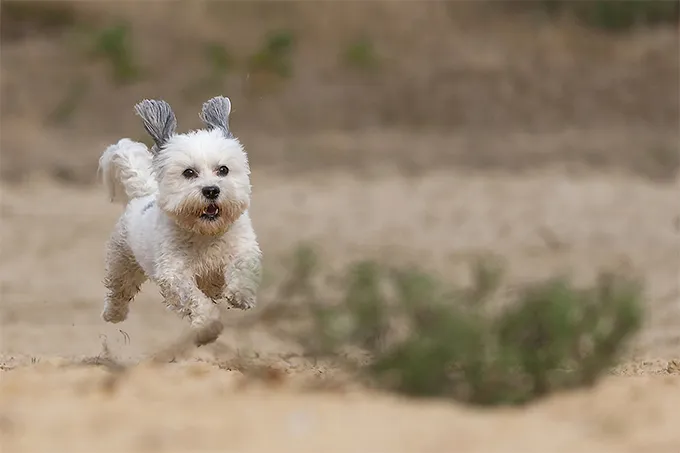
-
Maltese Shih Ztu Dog Breed Picture
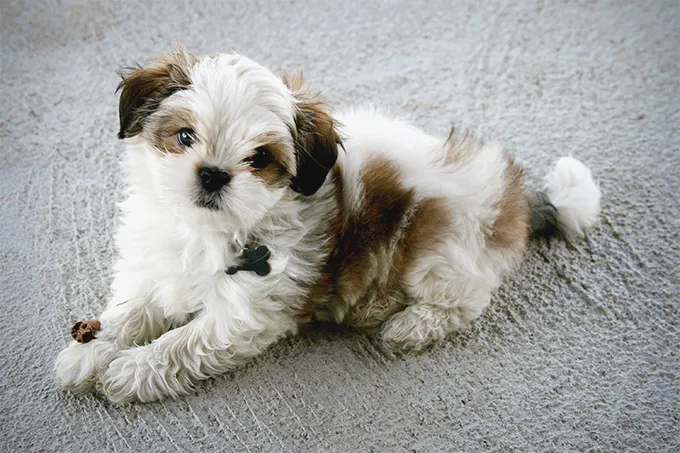
-
Maltese Shih Ztu Dog Breed Picture
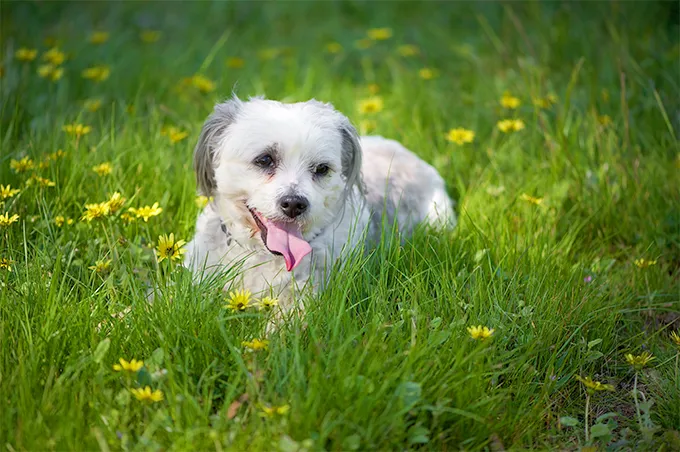
-
Maltese Shih Ztu Dog Breed Picture
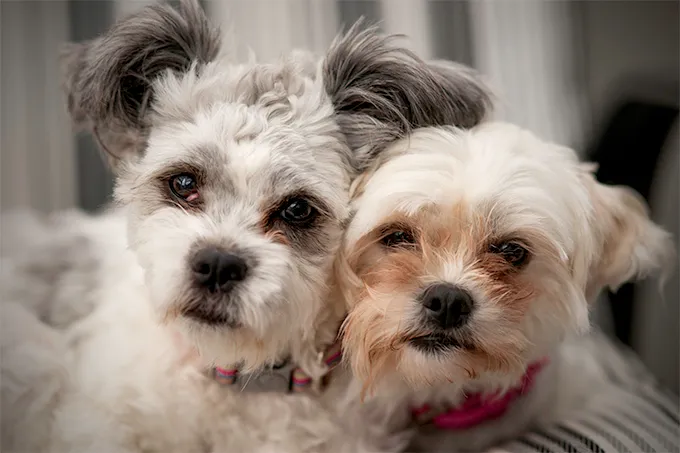
-
Maltese Shih Ztu Dog Breed Picture
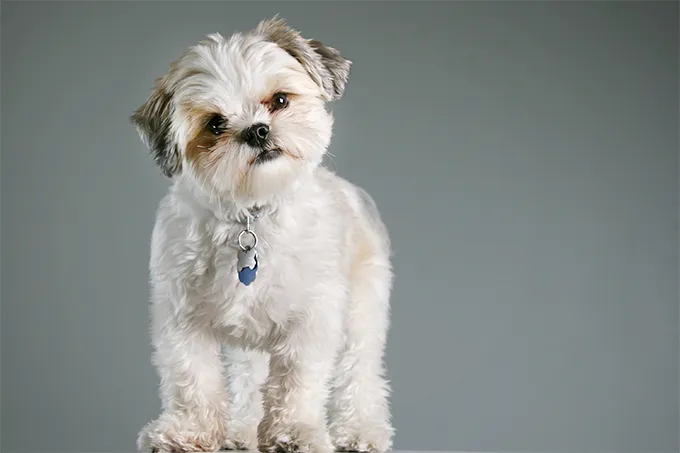
-
Maltese Shih Ztu Dog Breed Picture
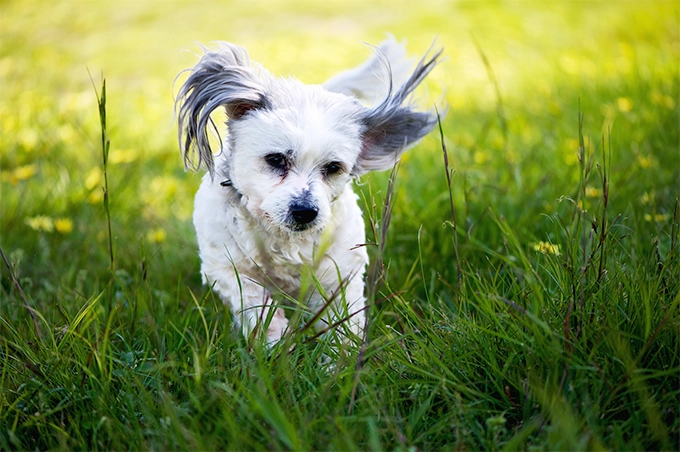
-
Maltese Shih Ztu Dog Breed Picture
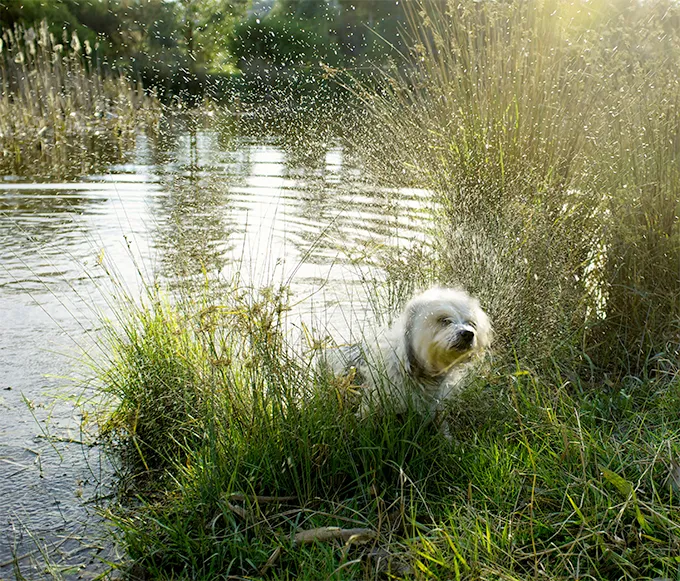
-
Maltese Shih Ztu Dog Breed Picture
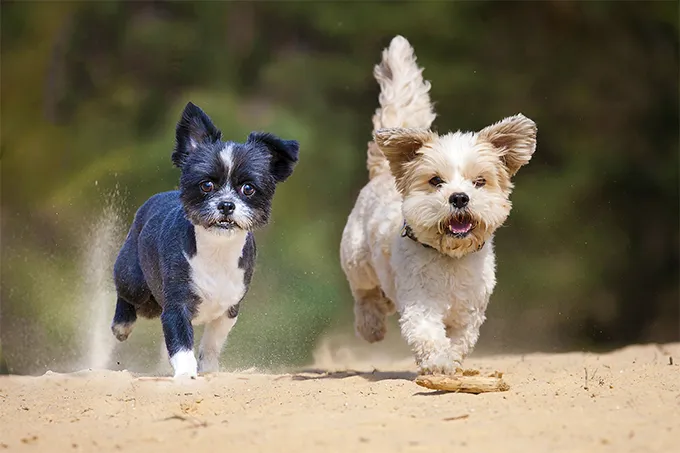
-
Maltese Shih Ztu Dog Breed Picture
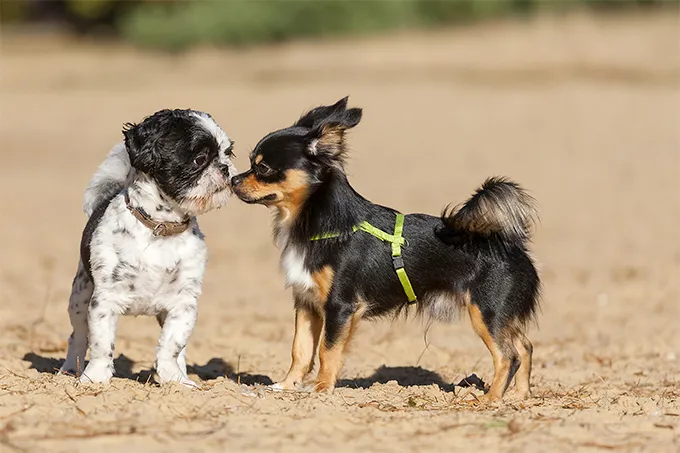
-
Maltese Shih Ztu Dog Breed Picture
